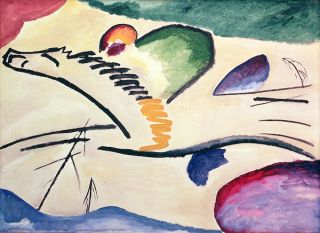Synesthesia
The Alchemy of Synesthesia
A remarkable, luminous way of experiencing the world.
Updated July 24, 2023 Reviewed by Lybi Ma
Key points
- Synesthesia has been known for well over 200 years but its precise definition and cause remain elusive.
- Cross-modal connections can involve all senses but most commonly color with letters and numbers.
- Pathological conditions like sensory loss or the use of hallucinogens can induce synesthesia-like experiences.
- It is often associated with highly creative people in the fields of literature, music, and the visual arts.

"The long a of the English alphabet … has for me the tint of weathered wood, but a French a evokes polished ebony. A hard g has the color of vulcanized rubber and r, a sooty rag…" writes Vladimir Nabokov, in his autobiography (Speak, Memory).
Nabokov's synesthesia also appears in his book The Gift: the protagonist, a writer, describes how the letter a is a different color in each of the four languages he speaks—"from lacquered black to splintery gray" (1963.)
Nabokov first noticed his special sense when, at age 7, he told his mother that his alphabet blocks were all the wrong color. His mother agreed and admitted that she, too, saw colors not only in letters but also in music.
Of his "colored hearing," Nabokov writes, "The confessions of a synesthete must sound tedious and pretentious to those who are protected from such leakings and drafts by more solid walls than mine are."
Nobel Prize-winning physicist Richard Feynman has also described, that he, too, saw letters in colors "when I see equations...with light tan j's, slightly violet-bluish n's, and dark brown x's flying around" (1988.)

And Russian painter Wassily Kandinsky wrote of "scented colors," the "sound of colors," and the "hearing of colors" (1997; 1994), though some have considered his vivid "cross-modal" sensory descriptions "metaphorical" (Ione and Tyler, 2003; 2004) rather than as evidence of actual synesthesia.
Literary synesthesia is "any use by a writer of intersensory imagery, that is, a metaphor of the senses" (Ruddick, 1984.) Poetry, for example, lends itself to translating one sense into another: Emily Dickinson's images are rife with synesthetic overtones, but there is "no evidence that she ever experienced clinical synesthesia" (Ruddick.)
Likewise, the French poet Rimbaud may have experienced synesthesia. He writes in Vowels (Voyelles) (1883) of bloody and foul-smelling images: "Black A, white E, red I, green U, blue O, though his writing, too, may reflect another example of literary synesthesia.

Further, a short poem by William Carlos Williams, The Great Figure, inspired the American artist Charles Demuth to paint, "I Saw the Figure 5 in Gold," (1928). The image is reflective of a synesthetic experience.
Some suggest that those with synesthesia demonstrate "heightened creativity" and are more likely to gravitate to literature, music, and the visual arts. But it may be that experiencing unusual perceptions "biases" them toward choosing these fields (Ward et al, 2008.)
Synesthesia is difficult to comprehend for those who have not experienced it (Curwen, 2018). Artist Carol Steen, herself a synesthete, provides "visually arresting" descriptions of textures "like the softest silk velvet" or luminous colors "falling like the waves of the aurora borealis" (Steen, 2001). She created her painting Vision after an image she experienced during acupuncture.
Synesthesia has been known for well over 200 years though "a precise definition of what it is and is not, remains a matter of some debate" (Ward, 2013). A 19th-century Austrian physician provided the first medical account of his synesthesia (Jewanski et al, 2009).

Over 60 different manifestations, triggered by some stimulus, either within the environment or precipitated internally by thought, have been reported (Jewanski and colleagues, 2011; Safran and Sanda, 2015). The most common are days of the week, letters, numbers, shapes that produce colors, and voices or music that produce colors or textures, but any sense pairing is possible (Suslick, 2012). Prevalence depends on the type of synesthesia, but reportedly, it occurs in up to 4 percent of the general population (Curwen). Those with synesthesia can have more than one cross-modal connection.
Synesthesia is involuntary, non-random, and automatic, and those with it report they "cannot start or stop their synesthesia at will." Further, the experiences, which can last from seconds to several minutes (Steen), are highly specific and consistent with repeated exposure (Schwartzman et al, 2019).
Those with synesthetic responses have been divided into "projectors" and "associators." Projectors experience their responses as being "out there," that is, in space, whereas "associators report their responses as being "in their mind's eye" (Mylopoulos and Ro, 2013).
Synesthesia, though subjective and a "behaviorally defined condition," (Lalwani and Brang, 2019) is a "genuine phenomenon that cannot be reduced to associative learning, a vivid imagination or metaphorical thinking" (Ward, 2013). No specific test, though, can diagnose it. Researchers have focused on establishing consistency of response, and sometimes the Stroop color interference test is used, but it is insufficient to confirm a diagnosis (Curwen).
The cause of synesthesia is unknown. Multiple genes likely create a propensity for it to develop in families (that is, developmental synesthesia), such as seen with Nabokov and his mother (Ward). It is not considered pathological (Jewanski et al, 2011).

Certain acquired pathological conditions, though, such as the sensory loss of blindness, or induction pharmacologically, as with hallucinogens like LSD, can induce synesthesia-like experiences artificially. These experiences are often inconsistent and not automatic, and "the similarities with natural synesthesia are likely only superficial" (Schwartzman et al).
Though the cause of synesthesia is unknown, there are two major hypotheses: the hyperconnectivity theory (that is, increased connectivity due to decreased neural pruning among areas of the brain) (Lalwani and Brang) and the disinhibited feedback theory (that is, decreased inhibition through feedback paths) (Curwen). A novel, third model, hypothesizes that those with synesthesia have increased "neural noise" in sensory regions that create "supra-threshold activation," that is, a synesthetic experience (Lalwani and Brang).
Earlier neuroimaging studies have been inconclusive (Curwen; Hupé and Djat, 2015). More recently, researchers though, have demonstrated differences, such as in evoking stronger activation in sensory areas and visual evoked potentials as measured by EEG, between those with and those without synesthesia (Lalwani and Brang).
While synesthesia is "a remarkable way of perceiving the world," (Ward), those with misophonia--literally "hatred of sound" suffer from a different perceptual condition: certain innocuous or repetitive sounds such as chewing, pen clicking, and lip-smacking, made by other people engender a "disproportional aversive" autonomic arousal (Edelstein and colleagues, 2013).

Also known as "selective sound sensitivity," misophonia is a relatively new diagnosis where those affected are often "hyper-focused" on background noise. It has been described as "sound-emotion synesthesia" (Duddy and colleagues, 2014). Unlike other synesthetic experiences, though, it can be "impairing" because it triggers "negative emotional, physiological, and behavioral responses," including anger, agitation, and disgust (Mattson and colleagues, 2023).
Note: Special thanks to Steven Heymsfield, MD for suggesting the topic of synesthesia and calling my attention to misophonia.
References
Curwen C. (2018). Music-colour synaesthesia: concept, context and qualia. Consciousness and Cognition 61: 94-106.
Duddy DF; Kristi AM; Oeding, AuD. (2014): Misophonia: an overview. Seminars in Hearing 35(2): 84-91.
Edelstein M et al (2013). Misophonia: physiological investigations and case descriptions. Frontiers in Human Neuroscience 7(Article 296): 10.3389/fnhum.2013.00296. (6 pages).
Feynman RP. (1988). ‘What Do You Care What Other People Think?’ New York: W.W. Norton & Company, p. 65.
Hupé J-M; Dojat M. (2015). A critical review of the neuroimaging literature on synesthesia. Frontiers in Human Neuroscience 9 (Article103): 10.3389/fnhum.2015.00103. (36 pages).
Ione A; Tyler C. (2003). Neurohistory and the arts: was Kandinsky a synesthete? Journal of the History of the Neurosciences 12(2): 223-226.
Ione A; Tyler C. (2004) Neuroscience, history and the arts. Synesthesia: is F-sharp colored violet? Journal of the History of the Neurosciences 13(1): 58-65.
Jewanski J; Day SA; Ward J. (2009). A colorful Albino: the first documented case of synaesthesia, by Georg Tobias Ludwig Sachs in 1812. Journal of the History of the Neurosciences 18(3): 293-303.
Jewanski J et al (2011). The development of a scientific understanding of synesthesia from early case studies (1849-1873). Journal of the History of the Neurosciences 20: 284-305.
Kandinsky W. (1977). Concerning the Spiritual In Art. Translated by M.T.H. Sadler. Garden City, New York: Dover Publications, pp. 24-25.
Kandinsky W. (1994). Complete Writings on Art. Edited by Kenneth C. Lindsay and Peter Vergo. New York: Da Capo Press, Inc, a member of the Perseus Books Group, pp. 157-9.
Lalwani P; Brang D. (2019). Stochastic resonance model of synaesthesia. Philosophical Transactions of the Royal Society B 374: 20190029. (15 pages).
Mattson SA et al (2023). A systematic review of treatments for misophonia. Personalized Medicine in Psychiatry: 39-40: 10.1016/jpmip. 2023.100104 (18 pages.)
Mylopoulos MI; Ro T. (2013). Synesthesia: a colorful word with a touching sound? Frontiers in Psychology 4 (Article 763): 10.3389/fpsyg.2013.00763 (9 pages.)
Nabokov V. (1998). Speak, Memory: An Autobiography Revisited. New York: Alfred A. Knopf Everyman’s Library (pp. 20-22).
Nabokov V. (1963). The Gift. Translated by Michael Scammell. New York (1991): Vintage International, a Division of Random House, Inc, p. 74.
Rimbaud A. Vowels. https://allpoetry.com/Vowels (Retrieved 7/21/23.)
Ruddick N. (1984). ‘Synaesthesia’ in Emily Dickinson’s Poetry. Poetics Today 5(1): 59-78.
Safran AB; Sanda N. (2015). Color synesthesia. Insight into perception, emotion and consciousness. Current Opinion in Neurology. 28(1):36-44.
Schwartzman DJ et al (2019). Neurophenomenology of induces and natural synaesthesia. Philosophical Transactions of the Royal Society B. 374 (1987): 20190030. (10 pages.)
Steen C (2001). Visions shared: A firsthand look into synesthesia and art. Leonardo 34(3): 203-208.
Suslick KS. (2012). Synesthesia in science and technology: more than making the unseen visible. Current Opinion in Chemical Biology 16(5-6): 557-563.
Ward J et al. (2008). Synaesthesia, creativity and art: what is the link? British Journal of Psychology 99: 127-141.
Ward J. (2013). Synesthesia. Annual Review of Psychology 64: 49-75.




